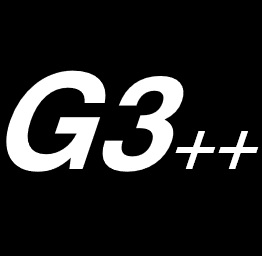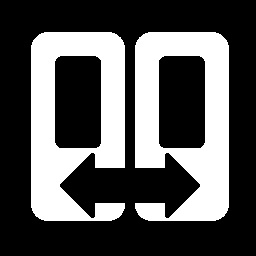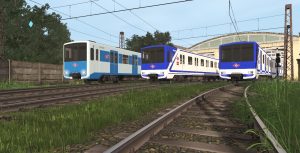Part 3 of the Metro Madrid 5000 Series pack. Jump to the previous part.



 From left to right: original two-tone light blue livery and the blue and white livery as applied from the late 1990s onwards, both in the “standard” scheme with white doors, as well as in the “blue doors” scheme recently introduced for accessibility requirements.
From left to right: original two-tone light blue livery and the blue and white livery as applied from the late 1990s onwards, both in the “standard” scheme with white doors, as well as in the “blue doors” scheme recently introduced for accessibility requirements.
DOWNLOAD
All the necessary dependencies are either included in this package or are avaible on the DLS. Soundscript by Rizky_Adiputra.
Missing a tracksound? Download this.
The 5500 Series was introduced in the first half of the 1990s, as the “loop” of the circular Line 6 neared completion, to enlarge the wide-profile fleet of the Madrid Metro so that it could cover services over the expanding network.
At the time, the wide-profile fleet was formed of 130 two-car sets (260 cars) evenly split between the 1st-batch 5000 Series of the mid-70s and the 2nd-batch 5200 Series of the early 1980s, two essentially identical fleets (barred the difference in traction equipment, rheostatic contactor-control for the 5000s, chopper control for the 5200s, and some other minor bodyshell differences) wich were enough to cover a good portion of the services on the envisioned completed network. As such, the fleet increase made necessary by the looming completion of the Line 6 loop, about a dozen or so trains, wasn’t considered large enough to warrant a completely new wide-profile design, with Metro Madrid opting for an additional, and ultimately final, batch of 5000 Series trains.
The main rationale behind this decision was the possibility of maximising spare parts compatibility with the older, much larger fleets, and as such, the new 5500 Series trains, officially known as the “4th batch” 5000 Series (3rd being the ill-fated batch for wich only the intermediate trailers were procured in the latter half of the 1980s) retained from the older batches the vast majority of equipment “subject-to-wear”, namely the bogeys, doors and other mechanical equipment, but also, for design simplification reasons, the same general bodyshell outline and arrangment of the 5200 Series and abortive 3th-batch specifically. However, given that the original 5000 Series desing was nearly 20 years old, the general appearance of the new trains was radically modified, with the slightly slanted outlook of the older batches being changed for a full square box-like appearance with a vertical front, made “softer” by the rounding of the edges. Another major external design change was with the front and rear windows, wich were enlarged so as to mimick a single, wide one (even tough they had to retain the required front and rear emergency doors).
A good deal of care was also taken to modernize their interior design, adopting a number of fetaures (primarily the celling and lighting system) from the narrow-profile 2000 Series, introduced in 1985 and still in production at the time. Another notable change was the introduction of door-opening buttons, whereas previous trains all had driver-opened automatic doors.
Finally, major changes were made also in terms of traction equipment, with the 5500 Series being equipped with a three-phase VCVF system similar to the 2000 Series, exactly as was previously intended for the 3rd-batch trains.
Like the rest of the 5000 Series fleet, the manufacturing contract for thirty-six 5500 Series 2-car sets (72 cars) went to CAF in 1991, wich had them built in it’s Besanin and Zaragoza plants, using traction equipment – both motors and controllers – supplied by the german AEG.
Production was actually wrapped up ahead of schedule, and the whole 5500 Series of thirty-six 2-car sets was promptly delivered to Metro Madrid in 1993, entering revenue service later that year, but not on Line 6 – on Line 9 instead. This was done to further “shuffle around” the fleet, so that Line 6, wich already had a majority of 5200 Series sets in service could recieve an as-uniform fleet as possible, with these 5200s being displaced from “their” lines by older 1st-batch 5000 Series sets themselves displaced from Line 9 by the arrival of the 5500 Series.
Nonetheless, around the late 1990s, with the delivery of the newer 6000 Series, wich took over the majority of Line 9 services, the 5500 Series fleet was eventually reassigned fully to Line 6, on wich they would end up serving the vast majority of their careers. At around the same time as well, their original two-tone light blue livery (based on the one of the earlier 1st-batch 5000s and 2nd-batch 5200s, but with a different pattern design) started being replaced by Metro Madrid’s new “standard” blue and white one.
In 1998, a few 5500 Series sets were also transferred to the newly-opened Line 11, running between Plaza Elliptica and Pan Bendito, built, like all newer lines to the wide-profile standards. However, 5500 Series sets would only briefly remain on this short line, as due to the lower passenger demand, and especially the need for those wide-profile sets elsewhere, in October 2000 these would be replaced by surplus narrow-profile 2000 Series sets (with the station platform being retrofitted with provisional “extensions” to bridge the gap) and returned to the other wide-profile lines.
The 5500 Series’ career would remain relatively uneventful for another decade, up until the late 2000s, when the first major modification occourred, as Line 6 (wich by then had become the most heavily-used line in the Madrid Metro network) was in the process of being upgraded to allow for shorter service intervals by replacing the older fixed-block ATC system with a moving bloc CBTC system. As part of this, six out of twelve (6-car) 5500 Series trains (as well as 22 of the 2nd-batch 5200 Series sets) were retrofitted with CBTC equipment.
The remaining non-CBTC fitted trains were replaced by the CAF-built 8000 Series and gradually returned to Line 9, to mitigate the rolling stock shortage caused by the “over-sale” of the 6000 Series to the Buenos Aires Subte in 2013.
As of today, with the retirement of the 1st batch 5000 Series in Summer 2011 and the abrupt withdrawal of the 2nd-batch 5200 Series in Spring 2018, the 5500 Series trains are the last of the “5000 Series family” still in service on the Madrid Metro, primarily running services on Line 9, as well as some residual rush-hour services on Line 6. Having surpassed the 30-year mark, their replacement will indirectly come by 2027, as Line 6 will be converted to driverless operation, the newer rolling stock in service (the afromentioned 8000 Series as well as it’s newer 8400 Series derivative) will be cascaded to the other wide-profile lines, fully replacing the 5500 Series.
